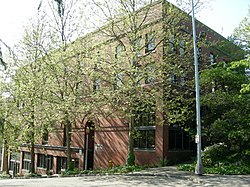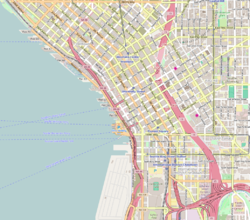Nippon Kan Theatre
Nippon Kan | |
 The Nippon Kan building, seen from the southeast (2007) | |
| Location | Seattle, Washington |
|---|---|
| Coordinates | 47°36′04″N 122°19′31″W / 47.601027°N 122.325387°W |
| Built | 1909 |
| Architect | Thompson & Thompson |
| NRHP reference No. | 78002754 [1] |
| Added to NRHP | May 22, 1978 |
The Nippon Kan Theatre (日本館劇場, Nippon-kan Gekijō) is a former Japanese theater in Seattle, Washington, United States. It is located in the Kobe Park Building at 628 S. Washington Street, in the former Japantown section of Seattle's International District.
History
Built in 1909 as a hotel, the Nippon Kan Theater later served as a de facto Japanese community center in Seattle prior to World War II. It was busy several nights a week with actors and musicians from Japan, movies, concerts, judo and kendo competitions, and community meetings.[2] The building is listed on the National Register of Historic Places.
The theater was boarded up in 1942 during the Japanese American internment, but reopened in 1981 through the restorative efforts of Seattle architect Edward M. Burke and his wife Betty.
In 2005 it was sold to ABC Legal Services and was used as converted office space. A replica of the curtain hangs on the wall along with several historic photographs. Its original closure has been attributed to the decreasing number of people of Japanese descent in Seattle.[3]

The theater's original stage curtain (used 1909–1915) survives, and now serves a similar purpose on the stage of the Tateuchi Story Theater of the nearby Wing Luke Museum. The curtain covered with advertisements was rediscovered in the 1970s. Because it used an asbestos material, it is now encased in a resin.[4]
See also
Notes
- ^ "National Register Information System". National Register of Historic Places. National Park Service. January 23, 2007.
- ^ Takami, David A. (1998). Divided Destiny: A History of Japanese Americans in Seattle. Univ of Washington Press. p. 28. ISBN 978-0295977621.
- ^ "Seattle loses icon of Japanese heritage" by Cecilia Kang, The Seattle Post-Intelligencer, November 26, 2005, retrieved March 28, 2006.
- ^ Marc Ramirez, Nippon Kan's long-lost curtain back on stage, Seattle Times, May 19, 2008; online version modified May 20, 2008. Accessed online 29 December 2008.
- Japanese-American culture in Seattle
- National Register of Historic Places in Seattle
- Theatres completed in 1909
- Buildings and structures in Seattle
- Theatres on the National Register of Historic Places in Washington (state)
- Hotel buildings on the National Register of Historic Places in Washington (state)
- 1909 establishments in Washington (state)
- Chinatown–International District, Seattle
- United States theater (structure) stubs

